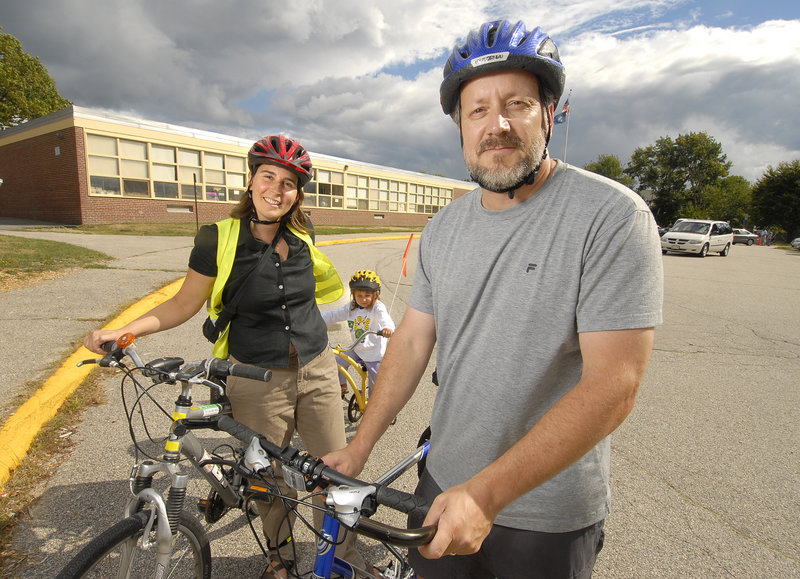PORTLAND – Making sure schools have enough bike racks is not the kind of big transportation initiative that rises to the top of anyone’s agenda. That might explain why schools in Portland have gone years without enough racks to meet demand. Some don’t have any.
Using funds from a federal grant aimed at reducing obesity rates, the city of Portland now has a new staff person whose job is to focus on these kinds of details as part of a more ambitious effort to make Portland a safer place for people to walk and ride their bikes.
Filling that post is Bruce Hyman, the city’s first-ever “bicycle and pedestrian program coordinator.”
Hyman, 48, who lives in North Deering, commutes to his office at the Public Services Department on Portland Street on his bicycle two or three times a week. But he’s not a dreamy-eyed bike advocate. He has been a land-use and transportation planner in the Portland area for 18 years.
His background in engineering and planning gives him credibility when dealing with state officials and road engineers, said Christian MilNeil, chairman of the Portland Bicycle/Pedestrian Advisory Committee, which recommended Hyman for the job.
At the same time, Hyman is a true believer in the value of making the city friendlier to bicycles and pedestrians, MilNeil said.
“He has worked hard on those things for a long time,” MilNeil said. “But he also knows the city and how to speak the engineering language.”
Hyman began work in June and has already produced results, said Sarah Cushman, who covers southern Maine for the state-funded Safe Routes to School program.
Within two weeks after he started, she said, Hyman produced nine grant applications for more than $2 million in funding for bicycle and pedestrian improvements, such as new bike lanes, sidewalks, safer street crossings, and traffic calming treatments.
One of Hyman’s tasks is to complete the city’s policy document to make sure that all street users are considered in the design and maintenance of streets.
“We are trying to re-think the way we design streets in Portland,” he said.
Hyman said he doesn’t believe in one-size-fits-all solutions, such as installing bike lanes on every street. Rather, each road has a different context and needs its own solution, he said.
One grant application would make it safer for children walking home from Presumpscot School. Cars and trucks often speed on the busy street as they pass the school.
The $250,000 grant would fund flashing school zone warning signs and a traffic island or “refuge island” in the middle of Presumpscot Street so children could cross one lane of traffic at a time.
In addition, he’s seeking funds to rebuild a portion of the intersection of Presumpcot Street and Washington Avenue to create a tighter turning radius, forcing cars to travel at safer speeds when they turn. The project also would reduce the distance pedestrians have to travel to cross the two roads.
In 2004, a 10-year-old girl was hit by a car at the intersection while walking in a crosswalk on Washington Avenue on her way to school.
Many children ride the school bus because their parents don’t believe that crossing Washington Avenue is safe, Cushman said.
The funding for the improvements would come from federal money administered by the state. Hyman said he believes the city has a good chance of wining two to four grants.
Some of the other grant applications include:
• Funding to extend a sidewalk on Washington Avenue.
• Filling sidewalk gaps on Walton Street near McAuley High School.
• Creating a pedestrian refuge island across Washington Avenue and overhead pedestrian-activated flasher.
• Creating a bike lane connection from Bates Street to Back Cove Trail.
• Building a trail on West Commercial Street and sidewalk improvements on York Street.
Hyman’s $46,500 salary and benefits are funded for two years as part of a $1.8 million federal grant that Portland has received for programs that reduce obesity rates. The grant rules require that money be spent on projects that create new policies for increasing physical activity and improving nutrition. In addition, the city can spend the money on infrastructure improvements.
The money isn’t supposed to be spent on creating programs that can’t support themselves after the grant runs out in two years.
Joan Ingram, program director for the grant, said Hyman’s work is critical to the project’s objectives.
“We are trying to make it easier for people to make health choices,” she said.
And those bike racks? Hyman found some bike racks in storage at the Portland Arts & Technology High School. On Friday, one of the racks was installed at Reiche Community School, replacing an old one that was rusted. New racks in coming weeks will be installed at Longfellow School and possibly Deering High School.
Staff Writer Tom Bell can be contacted at 791-6369 or at
tbell@pressherald.com
Send questions/comments to the editors.



Success. Please wait for the page to reload. If the page does not reload within 5 seconds, please refresh the page.
Enter your email and password to access comments.
Hi, to comment on stories you must . This profile is in addition to your subscription and website login.
Already have a commenting profile? .
Invalid username/password.
Please check your email to confirm and complete your registration.
Only subscribers are eligible to post comments. Please subscribe or login first for digital access. Here’s why.
Use the form below to reset your password. When you've submitted your account email, we will send an email with a reset code.